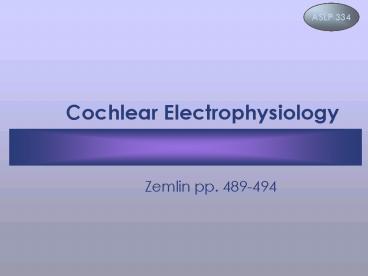Cochlear Electrophysiology - PowerPoint PPT Presentation
1 / 7
Title:
Cochlear Electrophysiology
Description:
ASLP 334. Cochlear Electrophysiology. Zemlin pp. 489-494. Lecture 7 ... Cochlear Microphonic (CM) Reproduces frequency and waveform of a sinusoid perfectly ... – PowerPoint PPT presentation
Number of Views:1094
Avg rating:3.0/5.0
Title: Cochlear Electrophysiology
1
Cochlear Electrophysiology
- Zemlin pp. 489-494
2
Electrical Potentials
- DC vs. AC
- Direct Current stimulus doesnt change with
time, constant i.e. battery - Alternating Current always changing over time,
looks like a sine wave - Stimulus Dependent vs. Stimulus Independent
- Stimulus Dependent potentials only present if
there is an acoustical sound present - Stimulus Independent potentials always present
with and without acoustical stimuli
3
Stimulus Independent vs. Dependent
- Stimulus Independent
- EP
- IP
- Stimulus Dependent
- SP
- CM
- AP
4
Three DC Potentials
- Endocochlear Potential (EP)
- Békésy discovered EP by putting the electrode in
the scala media and discovered a 100 mV
potential with respect to a neutral point on the
body - Tasaki discovered EP was due to the Stria
Vascularis - Intracellular Potential (IP) or organ of corti
potential - Recorded -50 mV inside cells of organ of corti
- Summating Potential (SP)
- DC that is only during very loud intensities of
acoustic stimulation
5
100 mV
Reticular Lamina
-50 mV
6
Two AC Potentials
- Cochlear Microphonic (CM)
- Reproduces frequency and waveform of a sinusoid
perfectly - Fig. 6-115 (p. 492)
- Generated from OHC
- Action Potential (AP)
- Electrical activity from the VIII Nerve
- Can be measured from anywhere in the cochlea or
in the auditory nerve
7
Differential Electrodes
- Measure the CM, we also measure the AP unless we
use differential electrodes - Tasaki (1954) was able to separate the CM AP by
using differential pair of electrodes - One electrode above reticular lamina (Scala Media
or Scala Vestibuli) and the other electrode in
the Scala Tympani - By changing the polarity, the AP cancels out,
while the CM is doubled in amplitude - This proved Békésys Traveling Wave Theory

